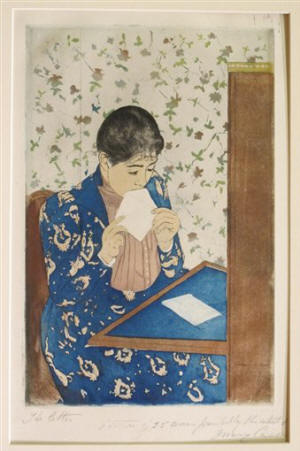| |||||||||
| |||||||||
Cassatt was just as skillful a draftsman as Edgar Degas or Camille Pissarro, said Higonnet. But she was "better with color and more conceptually inquiring about East-West and ideas about authorship. She not only signed each single impression of the print, which declared each one as a work of art, she also signed some of the preliminary states of the prints, so she extended the notion of authorship in a way that's still resonating with us today." Once Cassatt produced the number of images she desired from a single plate
-- usually no more than 25 -- she would scratch the plate with a dry point needle so no one could pull any more impressions from it, said Viljoen. Occasionally, she'd make one final defaced impression from a canceled plate to show she was done with that image. The exhibition has six examples of impressions pulled from a canceled plate. Printmaking became an integral part of her artistic repertoire after Degas, a brilliant printmaker, urged Cassatt to experiment with the medium. Her first attempts were executed in his studio. "It was really through Degas that she became really invested in printmaking and started to make some of her more interesting prints," Viljoen said. "He really was very important for her as she began using this medium." The exhibition includes an original Degas print of Cassatt with her sister at the Louvre. There are also a number of prints inscribed by Cassatt to Avery and compositions that never passed through her dealer's hands.
The exhibition runs through June 23. ___ Online: http://www.nypl.org/ 
 In the "Letter," a drypoint and aquatint color print, Cassatt used a desk from her own Paris apartment to create the image of a woman seated at her writing desk sealing an envelope. The subject is Western but the decorative background wallpaper is inspired by patterns in Japanese woodblock prints.
In the "Letter," a drypoint and aquatint color print, Cassatt used a desk from her own Paris apartment to create the image of a woman seated at her writing desk sealing an envelope. The subject is Western but the decorative background wallpaper is inspired by patterns in Japanese woodblock prints.
[Associated
Press;
Copyright 2013 The Associated Press. All rights reserved. This material may not be published, broadcast, rewritten or redistributed.
News | Sports | Business | Rural Review | Teaching & Learning | Home and Family | Tourism | Obituaries
Community |
Perspectives
|
Law & Courts |
Leisure Time
|
Spiritual Life |
Health & Fitness |
Teen Scene
Calendar
|
Letters to the Editor